You know that: You want a change in the company and the management appoints an employee to commission the change (without management power). If you see this change officer again after a few months, you recognize a stressed and sad person and the change in the company may have progressed by 5%. Maybe that’s even you?
Change in the company is not easy and I often talk to blog readers on the phone who ask me for help with my own change project. There is good news and bad news. The bad thing is: You cannot overcome certain barriers in a company without power and you need a manager for help and the good thing is: I have put together great frameworks for everything else at the end of the article.
Resistance and change
Look at the picture below. You notice that we usually freeze in one state (comfort zone). We usually only leave this when the pressure of change (green) is stronger than our resistance.

Kurt Lewin then established in 1947 that change only takes place as soon as the force of necessity for change is stronger than that of habit. Employees go through roughly three phases: Thawing: In the phase of thawing, in which the pressing forces gain the upper hand, after a shock, the employee starts to perceive the change. Change: In the moving phase, changes are made and the new is tried out. Freezing: By the third phase we mean getting used to the new situation.
Now you are probably asking yourself: How can this model help me? I want to tell you that change in organization is based on pressure. There are two types of this:
- The management puts massive pressure on the employees
- The company has bad numbers and employees are scared for their jobs
Proactive changes with arguments such as: We have to make sure that we have the success of today also tomorrow, are usually rare.
Reading tip: Types of changes in the company
Management support is the most important thing!
Every change in the company requires pressure or the support of management. It is much easier for me to make changes now as a department head than before, as I was only a consultant for change officers without direct power. After some time without management support, these were often very unsuccessful and frustrated.
Why the management doesn’t support
But why didn’t these agents get any support? In good times of growth, companies tend to put decisions on the back burner, because we’re fine! There is simply no need!
The result: There is no change in the company and you can actually leave it alone. Make yourself a good day and post a few powerpoints every now and then. It is simply too difficult to change core processes without management support. They are then an alibi project so that one can say: Yes, we do Scrum, for example, but still need it for the introduction. However, the manager secretly does not want it to be finished but is at least forced to do so by external pressure.
If you do want to give it a try, talk to the manager openly and use the following arguments, which have at least helped me in 2 out of 50 cases:
- Make it clear that every decision leads to conflict and is always associated with risk
- There is nothing worse than not deciding. This is a renunciation of actively shaping the future.
- Changes can only be implemented with power.
Coaches as managers are not always optimal in a crisis
A second aspect is also managers who see themselves only as coaches over the years. They care one-sidedly about the development of their employees. But it is also a goal to make a profit. Sometimes tough decisions have to be made for that too.
Crises make it clear what is really important. We have often dealt with the wrong or secondary topics. Postponed deep changes because they are too uncomfortable. We often only become aware of this when the yields decline. If we did a lot of coaching and consensus beforehand, then in the really deep change process suddenly only decisions are made with power.
Changes must first be initiated by management and pressure must be generated. Often times, managers tend to have someone tasked with making the change and then the matter is done for you. But as a manager in particular, you have to take the first step and only then involve or lead the change team.
Interim conclusion: change has to come from above!
At least if the following prerequisite is met: The management wants the change, they will grab all resistance and pressure employees to implement them.
I assure you that profound changes are only successful if management or a manager is behind you. I even go so far as to say: If not, don’t even start!
You need power in the background, which creates pressure and clears blockers out of the way. When an employee says: No! If I don’t feel like it, there is nothing you can do as an agent about it. He needs the pressure of his boss.
Because all change projects in companies show one thing: They are only successful if the top management level consistently uses the power it has been given to make the necessary decisions and initiate the associated processes.
Now comes the problem: Your management has to spend a lot of time and energy trying to keep the pressure going. Comfortable managers often don’t feel like it or have a short breath. After 4 weeks, the help suddenly drops.
Surely this “exercise of power” and “pressure” sounds somewhat authoritarian to you. But there are certain situations like phase 1 (thawing) in Lewin’s model, which needs this power. By applying pressure, managers are only doing their job of being a manager. Then in phase 2 of Lewin you no longer need any pressure, because the stone has been set in motion!
Reading tip: Convince management
One or the other coach will certainly come up with arguments: change must be supported by the employees and this can also come from “below”. Of course that is the case, but what does a change from below or a change agent do? He convinces the management and takes “power” from above. Unfortunately, we still live in a fairly classic and hierarchical system.
Create emotional insight and know change processes!
“When the wind of change blows, some build walls and others build windmills (Chinese proverb). The introduction of virtual teams in particular causes major changes and rejection among some employees. Each employee goes through 7 steps until the change is accepted. Some employees go through these in seconds and others in years. Take a look at the following illustration.

Phase 1: shock
The need for change creates a shock through fear of a new situation. This leads to an inability to rationally reflect on the change. My recommendation during this time: communicate the change and then let the employees digest the shock for 1-2 weeks. They just announce that new changes are being introduced.
Phase 2: rejection
The shock is followed by strong rejection. You will notice this phase when employees start talking negatively about the change. In this phase, you as a manager should help the employees to understand why the change is being made and thus prepare for phase 3. Explain the drivers of change. See yourself as an advocate for change.
Phase 3: Rational Insight
After it is recognized that rejecting a change does not help, employees start to deal with the change rationally. You start to weigh up the advantages, take in the first information about the change and would like the first short-term steps to implement it. At this stage, communicate initial information on how to implement the change, but not the entire plan.
The difference between rational and emotional insight can be illustrated very well using the example of a fitness studio. I realize that I’m too fat based on data like body weight (rational insight) but I don’t go to the gym because I don’t want to (emotional insight).
Phase 4: Emotional insight
The emotional insight is the real turning point and it means for you as a manager to stay tuned. Employees begin to become familiar with the change and show themselves openly. In this phase, it is important to grant concrete project plans and initial test access to possible software tools.
Phase 5: learning
The employees have accepted the change and are starting to try out the new software tools and virtual working methods. Release initial training courses on software and methods as well as initial written guidelines for employees. Let the first teams work with the new processes or software tools.
Phase 6: realization
Have the employees fast in phase 5 Successes achieved with the software tools, these will change very quickly want to gradually adopt them in their everyday lives. Hire a nice administrator to assist you with using the software and ask for feedback to new processes by a process manager.
Phase 7: integration
Now the new software tools and way of working are taken for granted. Your task as a manager is now like a kind of “senior teacher” to monitor whether the new working methods are still adhered to after 2-3 weeks and relapses into old behavior are avoided.
My advice: Scan exactly what phase you are in and react correctly! At the beginning you defend the change and only start after phase 3 or 4 with the first process documentation. Before doing this, just advertise and put the necessary pressure on management. I notice that the main point is often that change officers react completely wrongly in certain phases and thus overwhelm the workforce and also themselves.
Conclusion and reading tips
Many managers fall into change processes from one extreme to the other. Your change officers are correspondingly insecure and the resistance in the company is correspondingly massive. It doesn’t matter whether the change comes from above or below: You need the power of management!
Frameworks in particular offer a good orientation for change processes. Many representatives start a change completely without this scientific knowledge and despair of the complexity. I hope that my tips will help you and I would like to give you some reading tips:
[werbung] [fotolia]


